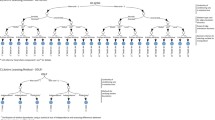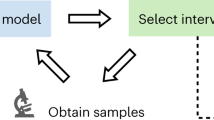Abstract
Machine learning methods for learning network structure, applied to quantitative proteomics experiments, reverse-engineer intracellular signal transduction networks. They provide insight into the rewiring of signaling within the context of a disease or a phenotype. To learn the causal patterns of influence between proteins in the network, the methods require experiments that include targeted interventions that fix the activity of specific proteins. However, the interventions are costly and add experimental complexity.
We describe a active learning strategy for selecting optimal interventions. Our approach takes as inputs pathway databases and historic datasets, expresses them in form of prior probability distributions on network structures, and selects interventions that maximize their expected contribution to structure learning. Evaluations on simulated and real data show that the strategy reduces the detection error of validated edges as compared to an unguided choice of interventions, and avoids redundant interventions, thereby increasing the effectiveness of the experiment.
Access this chapter
Tax calculation will be finalised at checkout
Purchases are for personal use only
Similar content being viewed by others
References
Bandura, D.R., Baranov, V.I., Ornatsky, O.I., Antonov, A., Kinach, R., Lou, X., Pavlov, S., Vorobiev, S., Dick, J.E., Tanner, S.D.: Mass cytometry: technique for real time single cell multitarget immunoassay based on inductively coupled plasma time-of-flight mass spectrometry. Anal. Chem. 81(16), 6813–6822 (2009)
Berger, J.O.: Statistical Decision Theory and Bayesian Analysis. Springer Science & Business Media, New York (2013)
Castelo, R., Siebes, A.: Priors on network structures. Biasing the search for Bayesian networks. Int. J. Approx. Reason. 24(1), 39–57 (2000)
Chen, T.J., Kotecha, N.: Cytobank: providing an analytics platform for community cytometry data analysis and collaboration. In: Fienberg, H.G., Nolan, G.P. (eds.) High-Dimensional Single Cell Analysis. Current Topics in Microbiology and Immunology, vol. 377, pp. 127–157. Springer, Heidelberg (2014). doi:10.1007/82_2014_364
Chickering, D.M.: A transformational characterization of equivalent Bayesian network structures. In: Proceedings of the Eleventh Conference on Uncertainty in Artificial Intelligence, pp. 87–98. Morgan Kaufmann Publishers Inc. (1995)
Chickering, D.M., Heckerman, D.: Efficient approximations for the marginal likelihood of Bayesian networks with hidden variables. Mach. Learn. 29(2–3), 181–212 (1997)
Cho, H., Berger, B., Peng, J.: Reconstructing causal biological networks through active learning. PloS ONE 11(3), e0150611 (2016)
Cooper, G.F., Yoo, C.: Causal discovery from a mixture of experimental and observational data. In: Proceedings of the Fifteenth Conference on Uncertainty in Artificial Intelligence, pp. 116–125. Morgan Kaufmann Publishers Inc. (1999)
Eaton, D., Murphy, K.P.: Exact Bayesian structure learning from uncertain interventions. In: International Conference on Artificial Intelligence and Statistics, pp. 107–114 (2007)
Eberhardt, F., Glymour, C., Scheines, R.: On the number of experiments sufficient and in the worst case necessary to identify all causal relations among N variables (2012). arXiv preprint: arXiv:1207.1389
Friedman, J., Hastie, T., Tibshirani, R.: Sparse inverse covariance estimation with the graphical LASSO. Biostatistics 9(3), 432–441 (2008)
Friedman, N.: Inferring cellular networks using probabilistic graphical models. Science 303(5659), 799–805 (2004)
Friedman, N., et al.: Learning belief networks in the presence of missing values and hidden variables. ICML 97, 125–133 (1997)
Friedman, N., Goldszmidt, M., Wyner, A.: Data analysis with Bayesian networks: a bootstrap approach. In: Proceedings of the Fifteenth Conference on Uncertainty in Artificial Intelligence, pp. 196–205. Morgan Kaufmann Publishers Inc. (1999)
Friedman, N., Koller, D.: Being Bayesian about network structure. A Bayesian approach to structure discovery in Bayesian networks. Mach. Learn. 50(1–2), 95–125 (2003)
Guan, Y., Dunham, M., Caudy, A., Troyanskaya, O.: Systematic planning of genome-scale experiments in poorly studied species. PLoS Comput. Biol. 6(3), e1000698 (2010)
He, Y.-B., Geng, Z.: Active learning of causal networks with intervention experiments and optimal designs. J. Mach. Learn. Res. 9(11), 2523–2547 (2008)
Heckerman, D., Geiger, D., Chickering, D.M.: Learning Bayesian networks: the combination of knowledge and statistical data. Mach. Learn. 20(3), 197–243 (1995)
Ide, J.S., Cozman, F.G.: Random generation of Bayesian networks. In: Bittencourt, G., Ramalho, G.L. (eds.) SBIA 2002. LNCS (LNAI), vol. 2507, pp. 366–376. Springer, Heidelberg (2002). doi:10.1007/3-540-36127-8_35
Ideker, T., Krogan, N.J.: Differential network biology. Mol. Syst. Biol. 8(1), 565 (2012)
Imoto, S., Kim, S.Y., Shimodaira, H., Aburatani, S., Tashiro, K., Kuhara, S., Miyano, S.: Bootstrap analysis of gene networks based on Bayesian networks and nonparametric regression. Genome Inform. 13, 369–370 (2002)
Kanehisa, M., Sato, Y., Kawashima, M., Furumichi, M., Tanabe, M.: Kegg as a reference resource for gene and protein annotation. Nucleic Acids Res. 44(D1), D457–D462 (2016)
King, R.D., Whelan, K.E., Jones, F.M., Reiser, P.G.K., Bryant, C.H., Muggleton, S.H., Kell, D.B., Oliver, S.G.: Functional genomic hypothesis generation and experimentation by a robot scientist. Nature 427(6971), 247–252 (2004)
Koller, D., Friedman, N., Models, P.G.: Principles and Techniques. MIT Press, Cambridge (2009)
Korb, K.B., Nicholson, A.E.: Bayesian Artificial Intelligence. CRC Press, Boca Raton (2010)
Margaritis, D.: Learning Bayesian network model structure from data. Ph.D. thesis, U.S. Army (2003)
Meganck, S., Leray, P., Manderick, B.: Learning causal Bayesian networks from observations and experiments: a decision theoretic approach. In: Torra, V., Narukawa, Y., Valls, A., Domingo-Ferrer, J. (eds.) MDAI 2006. LNCS (LNAI), vol. 3885, pp. 58–69. Springer, Heidelberg (2006). doi:10.1007/11681960_8
Murphy, K.P.: Active learning of causal Bayes net structure (2001)
Ness, R.O., Sachs, K., Vitek, O.: From correlation to causality: statistical approaches to learning regulatory relationships in large-scale biomolecular investigations. J. Proteome Res. 15, 683–690 (2016)
Pawson, T., Warner, N.: Oncogenic re-wiring of cellular signaling pathways. Oncogene 26(9), 1268–1275 (2007)
Pearl, J.: Causality: Models, Reasoning and Inference, vol. 29. Cambridge University Press, Cambridge (2000)
Perez, O.D., Nolan, G.P.: Simultaneous measurement of multiple active kinase states using polychromatic flow cytometry. Nat. Biotechnol. 20(2), 155–162 (2002)
Pournara, I., Wernisch, L.: Reconstruction of gene networks using Bayesian learning and manipulation experiments. Bioinformatics 20(17), 2934–2942 (2004)
Prill, R.J., Saez-Rodriguez, J., Alexopoulos, L.G., Sorger, P.K., Stolovitzky, G.: Crowdsourcing network inference: the DREAM predictive signaling network challenge. Sci. Signal. 4(189), mr7 (2011)
Rossell, D., Müller, P.: Sequential stopping for high-throughput experiments. Biostatistics 14(1), 75–86 (2013)
Russell, S.J., Norvig, P., Canny, J.F., Malik, J.M., Edwards, D.D.: Artificial Intelligence: A Modern Approach, vol. 2. Prentice Hall, Upper Saddle River (2003)
Sachs, K., Gentles, A.J., Youland, R., Itani, S., Irish, J., Nolan, G.P., Plevritis, S.K.: Characterization of patient specific signaling via augmentation of Bayesian networks with disease and patient state nodes. In: 2009 Annual International Conference of the IEEE Engineering in Medicine and Biology Society, pp. 6624–6627. IEEE (2009)
Sachs, K., Perez, O., Pe’er, D., Lauffenburger, D.A., Nolan, G.P.: Causal protein-signaling networks derived from multiparameter single-cell data. Sci. (N.Y., NY) 308(5721), 523–529 (2005)
Scutari, M.: Learning Bayesian networks with the bnlearn R package. J. Stat. Softw. 35(3), 1–22 (2010)
Scutari, M.: On the prior and posterior distributions used in graphical modelling. Bayesian Anal. 8(3), 505–532 (2013)
Terfve, C., Cokelaer, T., Henriques, D., MacNamara, A., Goncalves, E., Morris, M.K., van Iersel, M., Lauffenburger, D.A., Saez-Rodriguez, J.: CellNOptR: a flexible toolkit to train protein signaling networks to data using multiple logic formalisms. BMC Syst. Biol. 6(1), 1 (2012)
Terfve, C., Saez-Rodriguez, J.: Modeling signaling networks using high-throughput phospho-proteomics. In: Goryanin, I., Goryachev, A. (eds.) Advances in Systems Biology. Advances in Experimental Medicine and Biology, vol. 736, pp. 19–57. Springer, New York (2012). doi:10.1007/978-1-4419-7210-1_2
Tian, J., Pearl, J.: Causal discovery from changes. In: Proceedings of the Seventeenth Conference on Uncertainty in Artificial Intelligence, pp. 512–521. Morgan Kaufmann Publishers Inc. (2001)
Tong, S., Koller, D.: Active learning for structure in Bayesian networks. In: International Joint Conference on Artificial Intelligence, vol. 17, pp. 863–869. Lawrence Erlbaum Associates Ltd. (2001)
Werhli, A.V., Husmeier, D.: Reconstructing gene regulatory networks with Bayesian networks by combining expression data with multiple sources of prior knowledge. Stat. Appl. Genet. Mol. Biol. 6(1), 15 (2007)
Acknowledgements
We thank M. Scutari for guidance in using the R package bnlearn. This work was supported in part by the NSF CAREER award DBI-1054826, and by the Sy and Laurie Sternberg award to OV.
Author information
Authors and Affiliations
Corresponding author
Editor information
Editors and Affiliations
Rights and permissions
Copyright information
© 2017 Springer International Publishing AG
About this paper
Cite this paper
Ness, R.O., Sachs, K., Mallick, P., Vitek, O. (2017). A Bayesian Active Learning Experimental Design for Inferring Signaling Networks. In: Sahinalp, S. (eds) Research in Computational Molecular Biology. RECOMB 2017. Lecture Notes in Computer Science(), vol 10229. Springer, Cham. https://doi.org/10.1007/978-3-319-56970-3_9
Download citation
DOI: https://doi.org/10.1007/978-3-319-56970-3_9
Published:
Publisher Name: Springer, Cham
Print ISBN: 978-3-319-56969-7
Online ISBN: 978-3-319-56970-3
eBook Packages: Computer ScienceComputer Science (R0)




